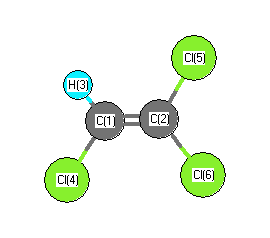Vibrational Frequencies calculated at HF/6-31G
| Mode Number |
Symmetry |
Frequency
(cm-1) |
Scaled Frequency
(cm-1) |
IR Intensities
(km mol-1) |
Raman Act
(Å4/u) |
Dep P |
Dep U |
|---|
| 1 |
A' |
3467 |
3130 |
16.69 |
|
|
|
| 2 |
A' |
1867 |
1686 |
5.35 |
|
|
|
| 3 |
A' |
1411 |
1274 |
14.04 |
|
|
|
| 4 |
A' |
968 |
874 |
89.62 |
|
|
|
| 5 |
A' |
840 |
758 |
97.75 |
|
|
|
| 6 |
A' |
641 |
579 |
15.27 |
|
|
|
| 7 |
A' |
397 |
358 |
0.01 |
|
|
|
| 8 |
A' |
284 |
257 |
0.93 |
|
|
|
| 9 |
A' |
182 |
164 |
1.82 |
|
|
|
| 10 |
A" |
1020 |
921 |
42.23 |
|
|
|
| 11 |
A" |
543 |
491 |
8.39 |
|
|
|
| 12 |
A" |
224 |
202 |
2.38 |
|
|
|
Unscaled Zero Point Vibrational Energy (zpe) 5921.1 cm
-1
Scaled (by 0.9029) Zero Point Vibrational Energy (zpe) 5346.2 cm
-1
See section
III.C.1 List or set vibrational scaling factors
to change the scale factors used here.
See section
III.C.2
Calculate a vibrational scaling factor for a given set of molecules
to determine the least squares best scaling factor.
Charges, Dipole, Quadrupole and Polarizability
Charges from optimized geometry at HF/6-31G
Charges (e)
| Number |
Element |
Mulliken |
CHELPG |
AIM |
ESP |
| 1 |
C |
-0.305 |
-0.041 |
|
|
| 2 |
C |
-0.432 |
0.160 |
|
|
| 3 |
H |
0.277 |
0.180 |
|
|
| 4 |
Cl |
0.117 |
-0.111 |
|
|
| 5 |
Cl |
0.154 |
-0.116 |
|
|
| 6 |
Cl |
0.190 |
-0.072 |
|
|
Electric dipole moments
Electric dipole components in Debye
(What's a Debye? See section
VII.A.3)
| |
x |
y |
z |
Total |
| |
-1.431 |
0.406 |
0.000 |
1.487 |
| CHELPG |
-1.499 |
0.388 |
0.000 |
1.549 |
| AIM |
|
|
|
|
| ESP |
|
|
|
|
Electric Quadrupole moment
Quadrupole components in D Å
| Primitive |
|---|
| | x | y | z |
|---|
| x |
-47.500 |
-1.124 |
0.000 |
| y |
-1.124 |
-53.267 |
0.000 |
| z |
0.000 |
0.000 |
-51.008 |
|
| Traceless |
|---|
| | x | y | z |
|---|
| x |
4.637 |
-1.124 |
0.000 |
| y |
-1.124 |
-4.013 |
0.000 |
| z |
0.000 |
0.000 |
-0.625 |
|
| Polar |
|---|
| 3z2-r2 | -1.249 |
|---|
| x2-y2 | 5.767 |
|---|
| xy | -1.124 |
|---|
| xz | 0.000 |
|---|
| yz | 0.000 |
|---|
|
Polarizabilities
Components of the polarizability tensor.
Units are
Å
3 (Angstrom cubed)
Change units.
| |
x |
y |
z |
| x |
7.569 |
0.828 |
0.000 |
| y |
0.828 |
10.438 |
0.000 |
| z |
0.000 |
0.000 |
2.384 |
<r2> (average value of r
2) Å
2
| <r2> |
269.335 |
| (<r2>)1/2 |
16.411 |
